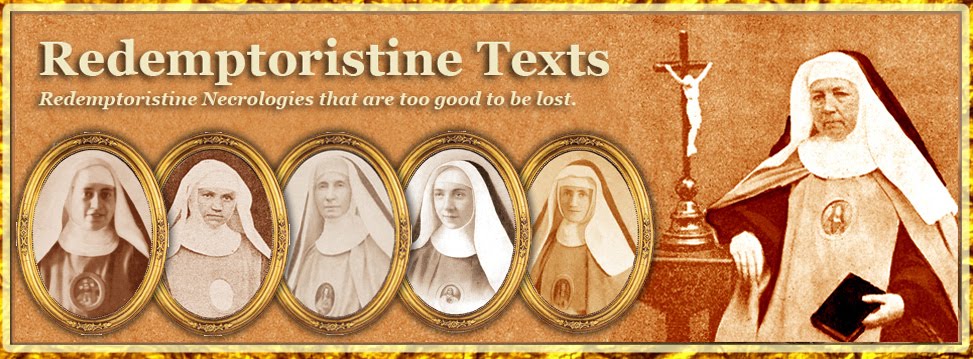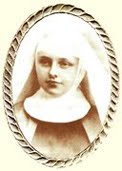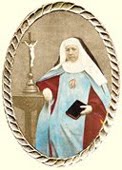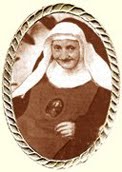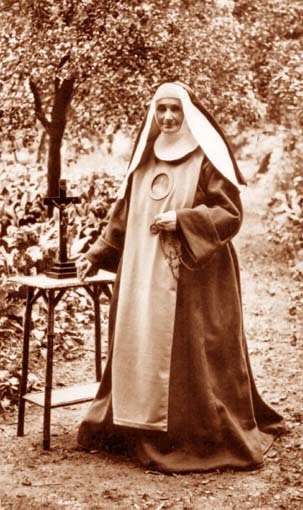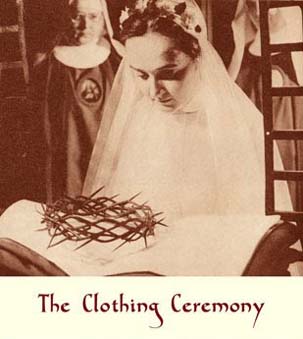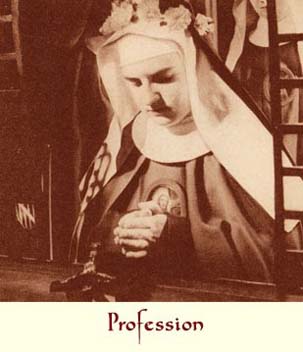I. First attractions to the religious life
Sister Mary-Seraphim of the Blessed Sacrament was born at Villarney on 6th February 1835. She was the second daughter of Mr. John Thomas Dewitt and Dame. Alice O’Connell, the niece of the great O’Connell who is so well known under the name of the Liberator of Ireland.
Miss Alice Mary O’Connell Dewitt was the standard-bearer for the Daughters of St. Alphonsus in Ireland.
In 1853, the Reverend Redemptorist Fathers were established in their little convent at Bank Place, Limerick. It was there that our future Sister learnt to appreciate the spiritual life by nourishing her ardent soul with the instructions of the good religious Fathers. She often told us that, early in the morning, she would escape from the paternal home in order to be one of the first to adore Jesus in the Blessed Sacrament under the roof of the Sons of St. Alphonsus, and also to pour out her fears and hopes at the feet of the Saviour, as she felt herself attracted to giving herself totally to God and becoming the Spouse of Jesus Christ.
Having heard them speak one day of an Order entirely consecrated to prayer, she conceived the great desire to enter it, and when she learned that these religious were the Daughters of Saint Alphonsus, her desire became all the more ardent. But many difficulties presented themselves. Alice had not yet attained the age of twenty-one, and her only sister was also resolved to embrace the religious life. Both of them had doubts about leaving their father, knowing how much this double sacrifice would cost him. They had already lost their mother some years previously.
On the 2nd of the month of August 1854, a friend of their father’s was preaching in the little church of St. Alphonsus. It was the Reverend Doctor Whelan, the Bishop of Bombay (India). The two sisters decided to ask His Lordship to make their father aware of their intimate desire. He promised to do so. As a religious himself (as he was from the Carmelite Order), he took an even greater interest in their position; and as he had been invited to dinner with the family the next day, the occasion appeared to have presented itself.
The result of the meeting was not in favour of the two sisters. What a disappointment it was when their father declared that he wished to test their vocation further. He promised the oldest that if she persevered in her resolution for another year, he would place no obstacle to her departure. As for Alice, he believed she was still too young to decide her vocation.
This refusal brought dismay to our future Sister, and her delicate health succumbed to it. Her father was so frightened by it and so greatly feared that death would bear his daughter away that he promised her that he himself would conduct her to the sanctuary of her choice, as soon as she recovered her strength. In October 1855, this good Christian, this good father, a new Abraham, brought his two daughters to Belgium. The one entered the convent of the Sisters of Notre Dame at Namur, and the other entered the convent of the Redemptoristines at Bruges as an Educande. Alice was thus the first Daughter of Saint Patrick who enrolled under the banner of Saint Alphonsus.
Miss Alice Mary O’Connell Dewitt was the standard-bearer for the Daughters of St. Alphonsus in Ireland.
In 1853, the Reverend Redemptorist Fathers were established in their little convent at Bank Place, Limerick. It was there that our future Sister learnt to appreciate the spiritual life by nourishing her ardent soul with the instructions of the good religious Fathers. She often told us that, early in the morning, she would escape from the paternal home in order to be one of the first to adore Jesus in the Blessed Sacrament under the roof of the Sons of St. Alphonsus, and also to pour out her fears and hopes at the feet of the Saviour, as she felt herself attracted to giving herself totally to God and becoming the Spouse of Jesus Christ.
Having heard them speak one day of an Order entirely consecrated to prayer, she conceived the great desire to enter it, and when she learned that these religious were the Daughters of Saint Alphonsus, her desire became all the more ardent. But many difficulties presented themselves. Alice had not yet attained the age of twenty-one, and her only sister was also resolved to embrace the religious life. Both of them had doubts about leaving their father, knowing how much this double sacrifice would cost him. They had already lost their mother some years previously.
On the 2nd of the month of August 1854, a friend of their father’s was preaching in the little church of St. Alphonsus. It was the Reverend Doctor Whelan, the Bishop of Bombay (India). The two sisters decided to ask His Lordship to make their father aware of their intimate desire. He promised to do so. As a religious himself (as he was from the Carmelite Order), he took an even greater interest in their position; and as he had been invited to dinner with the family the next day, the occasion appeared to have presented itself.
The result of the meeting was not in favour of the two sisters. What a disappointment it was when their father declared that he wished to test their vocation further. He promised the oldest that if she persevered in her resolution for another year, he would place no obstacle to her departure. As for Alice, he believed she was still too young to decide her vocation.
This refusal brought dismay to our future Sister, and her delicate health succumbed to it. Her father was so frightened by it and so greatly feared that death would bear his daughter away that he promised her that he himself would conduct her to the sanctuary of her choice, as soon as she recovered her strength. In October 1855, this good Christian, this good father, a new Abraham, brought his two daughters to Belgium. The one entered the convent of the Sisters of Notre Dame at Namur, and the other entered the convent of the Redemptoristines at Bruges as an Educande. Alice was thus the first Daughter of Saint Patrick who enrolled under the banner of Saint Alphonsus.
II. The Entry of Sister Mary-Seraphim into the Order of the Redemptoristines
The spirit of sacrifice which inspired our dear Educande was revealed when she entered the Monastery.
As she did not understand a word of French (she was the first educande who spoke English) she was not able to hold a conversation either with her mistress or even with her confessor without having continual recourse to a dictionary. And she was not able to make herself understood except with difficulty. The change of climate and food also made her suffer greatly, but all of this could not shake her. A visit to the Blessed Sacrament gave her the necessary strength. Jesus, however, Jesus Himself, knowing her generosity, hid from her the sweetness of His presence, but the faith of the courageous applicant did not weaken, and she would often exclaim: “O truly holy Sacrament, in You we truly have everything! Ego autem in Domino gaudebo, et exsultabo in Deo Jesu meo! [But I shall rejoice in the Lord, and I shall exult in Jesus my God!].
This joy, this happiness of heart in its sacrifice was always the character of her piety. Fifty years later, when she was asked one day if she would be happy if the Lord was to suddenly call her to Himself, she replied: “My Beloved is always with me, and I am always with Him.” These words were no more than the echo of her long life, and they were true, from her first days in religious life until her last breath. This was the first aspiration of the day when she prostrated herself before God to adore Him and consecrate all her being to Him.
On 7th January 1857, Mons Malou, the Bishop of Bruges, gave her the holy habit of the Redemptoristines and the name of Sister Mary-Seraphim of the Blessed Sacrament. During her novitiate, she was distinguished by her fervour, her generosity, and above all her obedience. On one occasion, she was told to take a remedy that she imagined was poison. She took it nonetheless, following the example of Saint Alfonso Rodriguez, and told herself like this great saint: “It is good to die in an act of holy obedience.”
On 25th January 1858, her ardent desire to become the Bride of Jesus Crucified was satisfied. The following year the Irish foundation was decided upon and our dear Sister Mary-Seraphim was one of the Sisters chosen to accompany our venerable foundress, the Reverend Mother Mary-Jean of the Cross. In all the trials and difficulties of this foundation, she showed herself as truly devoted, for she had learnt that true contemplation subjugates the senses as well as the search for self. At the ceremony of installation (25th March 1859) many members of the family of the great O’Connell was present, including his sister, Mrs. Moynihan, the grandmother of sister Mary-Seraphim, and her two daughters, Mrs. Fitzsimmon and Mrs. French. Thirty years earlier, the Liberator had, by his claims, as if laid the first stone of the edifice of the religious Orders in Ireland. Providence seemed to be rewarding him by ensuring that one of his little nieces was part of this community in Dublin that he doubtless looked at with love from the highest heaven.
Sister Mary-Seraphim was always a model of religious virtue. Her fervour never slackened, and her constant piety was never separate from her ardent love of regular observance. “Do not fear”, said Father Bridgett somewhere in an address for a religious profession, “that a long familiarity with God will make you love God less than you do now. Certainly it is not so. The knowledge that you have of the graces and perfections of your divine Spouse is very imperfect compared to what you are destined to have. If, in the world where you are occupied by cares, and by alluring pleasures or at least distracting ones, the divine attractions that Jesus has revealed to you are nonetheless powerful enough to show you how those pleasures are vain and insipid, and they have communicated to you a love capable of breaking down all the obstacles of flesh and blood – then we shall not have to wait until penance and prayer have purified more and more the eyes of your soul! Does not Jesus let His delights be revealed to the soul who seeks Him?"
As she did not understand a word of French (she was the first educande who spoke English) she was not able to hold a conversation either with her mistress or even with her confessor without having continual recourse to a dictionary. And she was not able to make herself understood except with difficulty. The change of climate and food also made her suffer greatly, but all of this could not shake her. A visit to the Blessed Sacrament gave her the necessary strength. Jesus, however, Jesus Himself, knowing her generosity, hid from her the sweetness of His presence, but the faith of the courageous applicant did not weaken, and she would often exclaim: “O truly holy Sacrament, in You we truly have everything! Ego autem in Domino gaudebo, et exsultabo in Deo Jesu meo! [But I shall rejoice in the Lord, and I shall exult in Jesus my God!].
This joy, this happiness of heart in its sacrifice was always the character of her piety. Fifty years later, when she was asked one day if she would be happy if the Lord was to suddenly call her to Himself, she replied: “My Beloved is always with me, and I am always with Him.” These words were no more than the echo of her long life, and they were true, from her first days in religious life until her last breath. This was the first aspiration of the day when she prostrated herself before God to adore Him and consecrate all her being to Him.
On 7th January 1857, Mons Malou, the Bishop of Bruges, gave her the holy habit of the Redemptoristines and the name of Sister Mary-Seraphim of the Blessed Sacrament. During her novitiate, she was distinguished by her fervour, her generosity, and above all her obedience. On one occasion, she was told to take a remedy that she imagined was poison. She took it nonetheless, following the example of Saint Alfonso Rodriguez, and told herself like this great saint: “It is good to die in an act of holy obedience.”
On 25th January 1858, her ardent desire to become the Bride of Jesus Crucified was satisfied. The following year the Irish foundation was decided upon and our dear Sister Mary-Seraphim was one of the Sisters chosen to accompany our venerable foundress, the Reverend Mother Mary-Jean of the Cross. In all the trials and difficulties of this foundation, she showed herself as truly devoted, for she had learnt that true contemplation subjugates the senses as well as the search for self. At the ceremony of installation (25th March 1859) many members of the family of the great O’Connell was present, including his sister, Mrs. Moynihan, the grandmother of sister Mary-Seraphim, and her two daughters, Mrs. Fitzsimmon and Mrs. French. Thirty years earlier, the Liberator had, by his claims, as if laid the first stone of the edifice of the religious Orders in Ireland. Providence seemed to be rewarding him by ensuring that one of his little nieces was part of this community in Dublin that he doubtless looked at with love from the highest heaven.
Sister Mary-Seraphim was always a model of religious virtue. Her fervour never slackened, and her constant piety was never separate from her ardent love of regular observance. “Do not fear”, said Father Bridgett somewhere in an address for a religious profession, “that a long familiarity with God will make you love God less than you do now. Certainly it is not so. The knowledge that you have of the graces and perfections of your divine Spouse is very imperfect compared to what you are destined to have. If, in the world where you are occupied by cares, and by alluring pleasures or at least distracting ones, the divine attractions that Jesus has revealed to you are nonetheless powerful enough to show you how those pleasures are vain and insipid, and they have communicated to you a love capable of breaking down all the obstacles of flesh and blood – then we shall not have to wait until penance and prayer have purified more and more the eyes of your soul! Does not Jesus let His delights be revealed to the soul who seeks Him?"
III. Sister Mary-Seraphim’s spirit of faith
Our dear Sister’s spirit of faith kept her elevated towards the region of her divine Spouse. She loved the Divine Office and showed great ardour in reciting it. A short time before her death, she begged the Mistress of Novices to strongly recommend them to put all their voices into it: “I understand nothing”, she said, “except that is a sublime privilege to recite it, and we should spare nothing in order to recite it as it should be.” She was always the first in choir for Matins, even under the weight of her seventy years. She so much loved to be there before the others, that the young Sisters sometimes used a little stratagem to get her to anticipate herself.
Our venerated Mother Mary-Jean of the Cross often told us: “I have had a bas-relief carved and put behind the altar, showing the twenty four oldest Sisters prostrate before the throne of the Lamb. [1] It is to remind you of the spirit of adoration with which you should recite the Office, and especially Matins.” Sister Mary-Seraphim took this observation strongly to heart: before reciting the Psalms, she would make a profound reverence and had an original little manner of also lifting up her breviary and raising her eyes to heaven.
In the last week of her life she was named hebdomadary for the last time, which caused her a noticeable pleasure. She often repeated the words of Macbeth: “If I must die, I shall die under the yoke.” Feast days and days of recreation were days of prayer for her, and she often went to choir and spoke frequently of the happiness of living under the same roof as the Blessed Sacrament.
Her spirit of faith was also shown in her relationship with her Superiors. Be they young or old, every word they said was considered by Sister Mary-Seraphim as the word of God, and their least desire was fulfilled on the spot. “I do not consider the person in my Superior”, she often said, “All I see in her is the representative of God.” And so she was always joyful and did everything according to her will, since she had no other will than the will of God.
Our dear Sister professed a tender love for our good Mother of Perpetual Succour. “I obtain everything”, she said, “by writing a little letter to the Queen of Heaven.” And when a Sister mentioned to her about being in pain or having some anxiety, she would reply: “It will all come out well, for I shall write a few words to my good Mother.” And everything did come out well.
How can we pass over in silence her filial love for our Father, Saint Alphonsus and the profound interest she took in the Congregation? The work of the missions made her move heaven and earth to gather a rich harvest and gain souls for God. Speaking to the Mistress of Novices, she asked her if she was pleased with her daughters, and added: “Be sure to tell them that they are not here only for themselves, but that they must pray and work for the salvation of souls. May they indeed give everything to Our Lord!” How happy she was to learn that they were profoundly attached to their vocation! “Blessed be God! Blessed be God!” she would then say fervently.
Our venerated Mother Mary-Jean of the Cross often told us: “I have had a bas-relief carved and put behind the altar, showing the twenty four oldest Sisters prostrate before the throne of the Lamb. [1] It is to remind you of the spirit of adoration with which you should recite the Office, and especially Matins.” Sister Mary-Seraphim took this observation strongly to heart: before reciting the Psalms, she would make a profound reverence and had an original little manner of also lifting up her breviary and raising her eyes to heaven.
In the last week of her life she was named hebdomadary for the last time, which caused her a noticeable pleasure. She often repeated the words of Macbeth: “If I must die, I shall die under the yoke.” Feast days and days of recreation were days of prayer for her, and she often went to choir and spoke frequently of the happiness of living under the same roof as the Blessed Sacrament.
Her spirit of faith was also shown in her relationship with her Superiors. Be they young or old, every word they said was considered by Sister Mary-Seraphim as the word of God, and their least desire was fulfilled on the spot. “I do not consider the person in my Superior”, she often said, “All I see in her is the representative of God.” And so she was always joyful and did everything according to her will, since she had no other will than the will of God.
Our dear Sister professed a tender love for our good Mother of Perpetual Succour. “I obtain everything”, she said, “by writing a little letter to the Queen of Heaven.” And when a Sister mentioned to her about being in pain or having some anxiety, she would reply: “It will all come out well, for I shall write a few words to my good Mother.” And everything did come out well.
How can we pass over in silence her filial love for our Father, Saint Alphonsus and the profound interest she took in the Congregation? The work of the missions made her move heaven and earth to gather a rich harvest and gain souls for God. Speaking to the Mistress of Novices, she asked her if she was pleased with her daughters, and added: “Be sure to tell them that they are not here only for themselves, but that they must pray and work for the salvation of souls. May they indeed give everything to Our Lord!” How happy she was to learn that they were profoundly attached to their vocation! “Blessed be God! Blessed be God!” she would then say fervently.
IV. Her confidence in God and her charity towards her neighbour
Sister Mary-Seraphim took an extreme pleasure in reading the works of our Father, Saint Alphonsus, and from them she drew a great love for the virtues that he recommends there so well, and in particular a tender confidence in God. The spirit of prayer penetrated her, and in all her difficulties or trials, in all her spiritual or temporal necessities, she would have recourse to her God with the confidence of a child: “One thought always consoles me”, she would say, “and that is that Our Lord is with us. He is always there.”
She gives us the most beautiful examples of humility, obedience and charity. Always sweet, always cheerful, how happy she showed herself when she was able to render some humble service to her neighbour! Obedience alone could make her lay down the broom for sweeping, and we may say that she never left hold of it until the end of her life. Even when she was losing her strength and eyesight, she never abandoned her charitable occupation, but she would call a young Sister to make sure that she had not left any dust behind. Because she was interested in everything, she would turn with a very good grace to help the Sisters in charge and showed great gratitude for the least services. She was very sensitive and easily moved to sympathy, and so she would say: “I feel everything and always”, and then she would add: “But I am placing myself above everything.” They begged her to slow down a little, but she replied: “We never know how far we can go. I want to go right to the end.”
When she was on her bed of sorrow in the last days of her life, she made this reply to a converse Sister who asked her for some advice: “Devote yourself to the community, and you will have a happy death.”
Her love of prayer and for her neighbour suggested to her that she should pray often and gain indulgences for the souls in Purgatory. She would most carefully collect the funeral notices of relatives, friends and benefactors. On each anniversary, they would reappear on her table at exactly the right time.
All the virtues of Sister Mary-Seraphim were inspired by her love of God. He was the soul of her thoughts and actions, and she recommended this above all to the Novices, during the few years when she had their direction. All her instructions tended to make them love God alone, and this was the supreme end that she unceasingly proposed for their efforts. It was a truly worthy preoccupation for a true daughter of Saint Alphonsus, the holy Doctor who had so well taught the ways of this love.
She gives us the most beautiful examples of humility, obedience and charity. Always sweet, always cheerful, how happy she showed herself when she was able to render some humble service to her neighbour! Obedience alone could make her lay down the broom for sweeping, and we may say that she never left hold of it until the end of her life. Even when she was losing her strength and eyesight, she never abandoned her charitable occupation, but she would call a young Sister to make sure that she had not left any dust behind. Because she was interested in everything, she would turn with a very good grace to help the Sisters in charge and showed great gratitude for the least services. She was very sensitive and easily moved to sympathy, and so she would say: “I feel everything and always”, and then she would add: “But I am placing myself above everything.” They begged her to slow down a little, but she replied: “We never know how far we can go. I want to go right to the end.”
When she was on her bed of sorrow in the last days of her life, she made this reply to a converse Sister who asked her for some advice: “Devote yourself to the community, and you will have a happy death.”
Her love of prayer and for her neighbour suggested to her that she should pray often and gain indulgences for the souls in Purgatory. She would most carefully collect the funeral notices of relatives, friends and benefactors. On each anniversary, they would reappear on her table at exactly the right time.
All the virtues of Sister Mary-Seraphim were inspired by her love of God. He was the soul of her thoughts and actions, and she recommended this above all to the Novices, during the few years when she had their direction. All her instructions tended to make them love God alone, and this was the supreme end that she unceasingly proposed for their efforts. It was a truly worthy preoccupation for a true daughter of Saint Alphonsus, the holy Doctor who had so well taught the ways of this love.
V. Last sacrifice and death of Sister Mary-Seraphim
One sacrifice remained for our good Sister to make, and she dreaded it. It was that of her love of reading. We know how useful a taste for good reading is for the spiritual life. During the last year of her life, Sister Mary-Seraphim had to renounce the advantage that she drew from it. Our Lord indeed sent her as her last cross this loss of her eyesight which made reading impossible. She endured it patiently and without complaint, put aside her cherished books, and although she was no longer permitted to recite the Divine Office, she always wished to be present in choir to hear it. But the days never seemed long to her. Rosaries succeeded rosaries, fatigue never made itself felt, and our good Sister could say with a smile: “I would never have believed that I could so easily give up books.”
Our Lord, satisfied with her sacrifice, gave her back her eyesight. However, Sister Mary-Seraphim’s health deteriorated. Yet the doctor saw nothing to be worried about, when suddenly, on 14th June 1905, he found our good Sister in serious danger. She was sent immediately to the infirmary, and the next day she received Extreme Unction and the Holy Viaticum. Her ardent piety found an indescribable consolation in it. On the 21st, her confessor, finding her close to her end, gave her a plenary indulgence. That night was a bad one, as a painful suffocation afflicted our good Sister, who suffered it all with an angelic patience, and repeated with no less fervour the pious aspirations that our Reverend Mother suggested to her. The following day was the feast of the Blessed Sacrament. The Lord was most willing to respond to the desires of His servant, and at ten o’clock, she had the happiness of receiving Him for the last time, on this feast that she had always loved so much. Our Reverend Mother and our dear Sisters continued to pray beside her bed, while the dear invalid said to her Superior: “I would not like to deprive my Sisters of the happiness of adoring the Blessed Sacrament exposed in the chapel.” They suggested this beautiful aspiration to her: “O divine Sacrament, we adore You; make us love You more and more.” “Yes”, she replied, “yes, more and more.”
At 1:30 a.m., Sister Mary-Seraphim repeated these aspirations with our Mother: “Jesus, Mary, Joseph, I give you my heart and my soul.” “Sweet Heart of Mary, be my salvation.” These were her last words, and she rendered her beautiful soul to God in peace and holiness. This was on 22nd June 1905. Our good Sister was in her 71st year and had been 48 years in profession.
The Ven. Fr. Passerat said that a professed religious must always remain a novice in her abnegation of will and judgement, with the simplicity of a child, and at this price he promised her constant peace, Paradise on earth and Heaven without Purgatory. Sister Mary-Seraphim practised this recommendation. God, we hope, will have rewarded her for it.
Our Lord, satisfied with her sacrifice, gave her back her eyesight. However, Sister Mary-Seraphim’s health deteriorated. Yet the doctor saw nothing to be worried about, when suddenly, on 14th June 1905, he found our good Sister in serious danger. She was sent immediately to the infirmary, and the next day she received Extreme Unction and the Holy Viaticum. Her ardent piety found an indescribable consolation in it. On the 21st, her confessor, finding her close to her end, gave her a plenary indulgence. That night was a bad one, as a painful suffocation afflicted our good Sister, who suffered it all with an angelic patience, and repeated with no less fervour the pious aspirations that our Reverend Mother suggested to her. The following day was the feast of the Blessed Sacrament. The Lord was most willing to respond to the desires of His servant, and at ten o’clock, she had the happiness of receiving Him for the last time, on this feast that she had always loved so much. Our Reverend Mother and our dear Sisters continued to pray beside her bed, while the dear invalid said to her Superior: “I would not like to deprive my Sisters of the happiness of adoring the Blessed Sacrament exposed in the chapel.” They suggested this beautiful aspiration to her: “O divine Sacrament, we adore You; make us love You more and more.” “Yes”, she replied, “yes, more and more.”
At 1:30 a.m., Sister Mary-Seraphim repeated these aspirations with our Mother: “Jesus, Mary, Joseph, I give you my heart and my soul.” “Sweet Heart of Mary, be my salvation.” These were her last words, and she rendered her beautiful soul to God in peace and holiness. This was on 22nd June 1905. Our good Sister was in her 71st year and had been 48 years in profession.
The Ven. Fr. Passerat said that a professed religious must always remain a novice in her abnegation of will and judgement, with the simplicity of a child, and at this price he promised her constant peace, Paradise on earth and Heaven without Purgatory. Sister Mary-Seraphim practised this recommendation. God, we hope, will have rewarded her for it.
(Monastery Chronicles)
Footnotes
[1] In imitation of the twenty four elders mentioned in the Apocalypse.
This necrology is translated from Fleurs de l'Institut des Rédemptoristines by Mr John R. Bradbury. The copyright of this translation is the property of the Redemptoristine Nuns of Maitland, Australia. The integral version of the translated book will be posted here as the necrologies appear.
